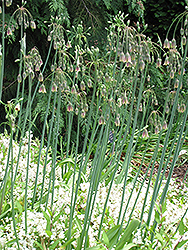Height: 4 feet
Spacing: 24 inches
Sunlight:
![]()
Hardiness Zone: 4a
Other Names: Allium bulgaricum, Honey Garlic
Description:
Make a bold statement with these nodding, bell-shaped flowers on 3' stems; makes an interesting cutflower; strong garlic smell; this flower drips nectar and attracts bees
Ornamental Features
Sicilian Honey Lily features bold fragrant nodding plum purple bell-shaped flowers with green overtones and white edges at the ends of the stems in late spring. The flowers are excellent for cutting. Its attractive grassy leaves remain bluish-green in colour throughout the season.
Landscape Attributes
Sicilian Honey Lily is an herbaceous perennial with tall flower stalks held atop a low mound of foliage. Its relatively fine texture sets it apart from other garden plants with less refined foliage.
This is a relatively low maintenance plant, and is best cleaned up in early spring before it resumes active growth for the season. It is a good choice for attracting bees to your yard. It has no significant negative characteristics.
Sicilian Honey Lily is recommended for the following landscape applications;
- Accent
- Mass Planting
- General Garden Use
Planting & Growing
Sicilian Honey Lily will grow to be about 4 feet tall at maturity, with a spread of 4 feet. When grown in masses or used as a bedding plant, individual plants should be spaced approximately 24 inches apart. It tends to be leggy, with a typical clearance of 1 foot from the ground, and should be underplanted with lower-growing perennials. It grows at a medium rate, and under ideal conditions can be expected to live for approximately 10 years. As an herbaceous perennial, this plant will usually die back to the crown each winter, and will regrow from the base each spring. Be careful not to disturb the crown in late winter when it may not be readily seen!
This plant should only be grown in full sunlight. It does best in average to evenly moist conditions, but will not tolerate standing water. It is not particular as to soil type or pH. It is somewhat tolerant of urban pollution. This is a selected variety of a species not originally from North America. It can be propagated by multiplication of the underground bulbs; however, as a cultivated variety, be aware that it may be subject to certain restrictions or prohibitions on propagation.
Disclaimer - This resource is provided for informational purposes only and does NOT reflect current availability. Inventory varies seasonally, so we cannot guarantee that every plant will be in stock at all times - please contact your favourite GardenWorks location directly for current availability. It does not include our entire inventory of plants, so be sure to visit GardenWorks to see varieties that may not be represented on this list.

